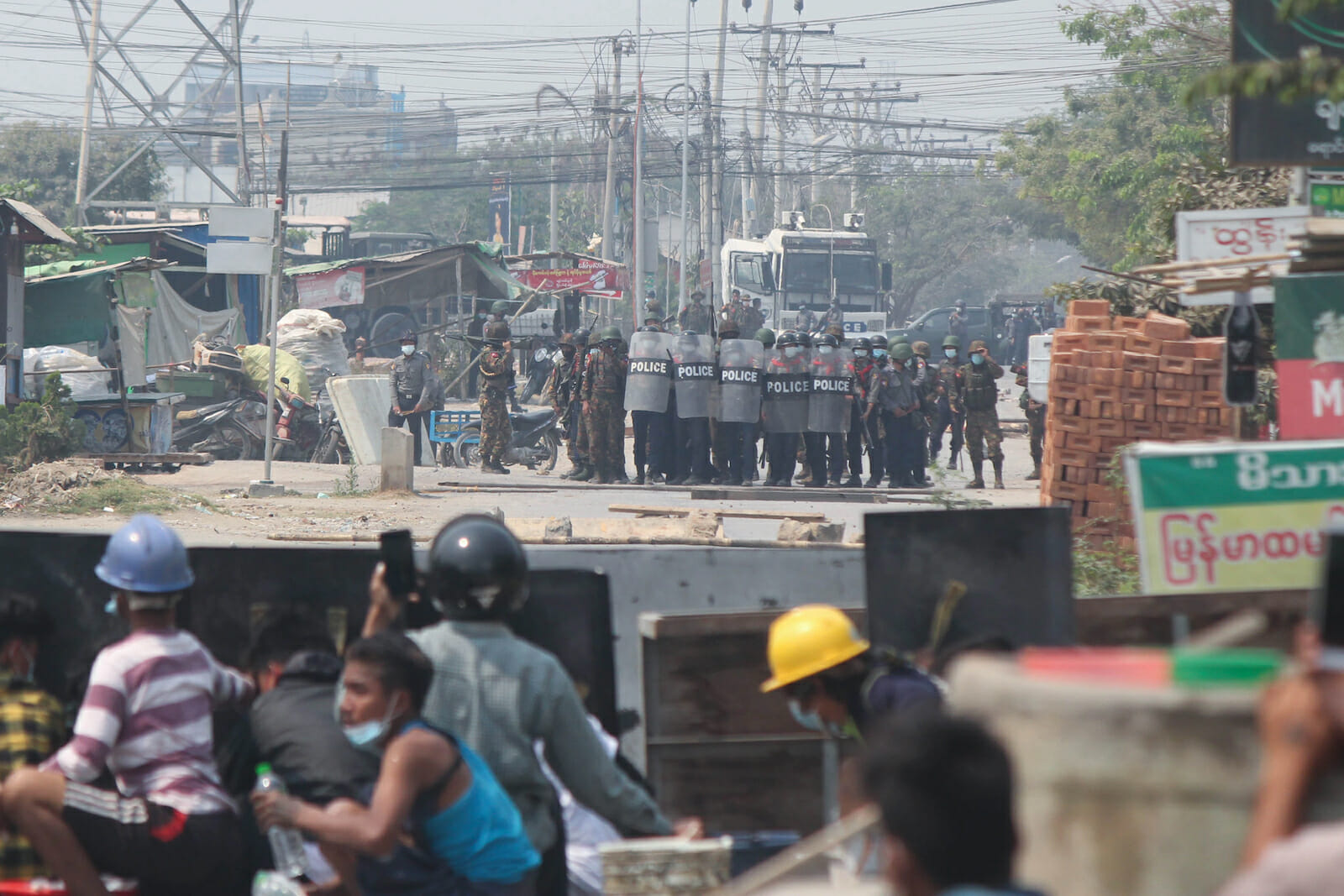
To Save Myanmar and Itself, ASEAN must be Bold
A fundamental principle of the Association of Southeast Asian Nations (ASEAN), a bloc comprising 10 countries in the Indo-Pacific, is the notion of non-interference. With its states, which include Brunei, Cambodia, Indonesia, Laos, Malaysia, Myanmar, the Philippines, Thailand, Singapore, and Vietnam, carrying varied cultural and political norms, ASEAN’s doctrine of non-interference has been a valuable mechanism to forge consensus and compromise to address problems. Yet, as casualties mount and anti-government resistance hardens in light of the crisis in Myanmar, which has seen the government open fire on peaceful protestors over the past week, ASEAN is under pressure to change this posture. Failure to act here could spell disaster for the bloc and its future.
Amidst the deteriorating situation in Myanmar, which has seen weeks of civil unrest after the military seized power and imprisoned many officials including members of Aung San Suu Kyi’s government last month, foreign ministers from all of ASEAN’s member states held virtual talks with the junta’s new foreign minister on March 2. However, the only substantive article the meeting provided was a tepid statement on the crisis issued by Brunei, the current ASEAN chair.
“We expressed our concern on the situation in Myanmar and called on all parties to refrain from instigating further violence, and for all sides to exercise utmost restraint as well as flexibility,” it said. “We also called on all parties concerned to seek a peaceful solution, through constructive dialogue. In this regard, we expressed [ASEAN’s] readiness to assist Myanmar in a positive, peaceful, and constructive manner.”
Apathy, in the face of a spiraling crisis, sets a dangerous precedent. On March 3, a day after the meeting, Reuters reported that 18 people were killed across the country after police shot protestors. That figure may be conservative. Various other foreign and local media cited reports that as many as 38 people had died. If Myanmar’s government were to continue its bloodbath unabated or if Myanmar were to disintegrate completely, what would this say about ASEAN’s diplomatic relevance?
Individually, some ASEAN members offered scathing remarks. In an interview with the BBC, Lee Hsieng Loong, Singapore’s prime minister, expressed his grave concern over the situation and condemned the military’s actions.
#Myanmar security forces fired at protesters who were reportedly demanding for the release of those arrested earlier in North Okkalapa township, eastern part of #Yangon. Am told at least 1 person has been critically hurt as seen in video sent to me #WhatsHappeninglnMyanmar pic.twitter.com/Aei0Dn7Owt
— May Wong (@MayWongCNA) March 10, 2021
“To use lethal force against civilians and unarmed demonstrators, I think it is just not acceptable,” said Lee in reference to the shootings. “That is disastrous not just internationally, but disastrous domestically, because it means that civilians, everybody in Myanmar, knows. You may try to squeeze down the Internet, but news gets around.”
Indonesia, ASEAN’s largest economy and the home of its secretariat, condemned the violence and urged restraint from Myanmar’s authorities, noting that it was “deeply concerned” with the situation.
“Indonesia urges the security forces to refrain from the use of force and exercise utmost restraint to avoid further casualties,” said a statement issued by Jakarta.
Despite these denunciations, as a bloc, ASEAN’s attitude to the situation has been perfunctory. This does little to obscure the gravity of the crisis it faces. While, since its founding in 1967, ASEAN has contended with numerous military coups, fraudulent election results, border disputes, and cases of political suppression, its devotion to non-interference allowed such events to pass without stoking regional tensions. Several coups in Thailand over the past two decades failed to raise eyebrows. Neither did political infighting in Malaysia last year or the banning of Cambodia’s main opposition party three years ago. Still, never before has ASEAN had to grapple with the potential collapse of one of its members.
The Myanmar crisis’ corollary is significant for other reasons. For one, it comes amidst a period of significant power competition in Southeast Asia. With the United States and China competing for regional influence, escalation in Myanmar risks triggering a geopolitical confrontation. Secondly, the broadcasting of the protests through social media has made it impossible for authorities in Naypyidaw to cloak their response. This has complicated efforts at suppression. Rather than scaring protestors away, the Tatmadaw’s use of violence risks spurring the movement further. On Sunday, March 7, tens of thousands of protestors continued to line the streets of Yangon in defiance of overnight raids by security forces on protest leaders.
With its principles of building consensus through non-interference, ASEAN represents both the problem and solution in Myanmar. While adherence to these commitments inhibits its ability to swiftly respond to crises, abiding by these norms potentially opens the door to backchannel negotiations with both sides.
If ASEAN is to navigate these waters, a strong regional leader must emerge to steer the bloc. Indonesia, its biggest economy, naturally fills this void. Following the coup on February 1, Retno Marsudi, Indonesia’s foreign minister, visited Brunei, Singapore, and Thailand to meet with her counterparts on the situation. These actions helped to instigate the virtual meeting that brought the military leadership to the table.
In statements, Marsudi called for Myanmar to release political detainees and to pursue a restoration of democracy, pledging at the same time that ASEAN would not break its principle of non-interference.
“Restoring democracy back on track must be pursued,” Retno said. “Indonesia underlines that the will, the interest, and the voices of the people of Myanmar must be respected.”
Police officers who fled Myanmar into India told @Reuters that they refused to obey orders to shoot anti-coup protesters https://t.co/UKZvrM3czI pic.twitter.com/HM5Mz1EqIF
— Reuters (@Reuters) March 10, 2021
Jakarta’s challenge will be finding a way to bridge the divided stances of ASEAN’s members. While the bloc’s democratically elected states of Singapore, Malaysia, and the Philippines expressed condemnation – its more authoritarian members, including Brunei, Cambodia, Laos, Thailand and Vietnam have so far only offered muted responses.
In a statement issued through their foreign ministry, Cambodia toed the line of Myanmar, noting that in the virtual meeting, foreign ministers merely “exchanged views on regional and international issues of interest and concern, including on the current developments in Myanmar.”
To find a solution to the crisis, ASEAN must harness its collective action and continue to engage with the Tatmadaw. Although the virtual meeting produced little, it provides scope for future discussions. This is a tall order. Given ASEAN’s principles of non-interference and consensus, the bloc has little maneuverability in this regard. Moreover, the Tatmadaw is heavily funded, powerful, and scornful of the international community. Its willingness to dig in, even as its economy collapses and civil society fall apart, speaks to a conviction that it has the stamina to outlast the protest movement.
If engagement with the Tatmadaw does not succeed at quelling tensions, which seems likely, ASEAN can look to thrust themselves further and institute channels for open dialogue between the military and civilians. While these actions may infringe upon the values of consensus and non-interference that the group holds, countries like Indonesia, Malaysia, and Singapore must be bold and pressure other member states to take a brawnier stance. Only under collective pressure from its members can ASEAN secure sufficient political capital to bring both sides to the table.
While the military may be prepared to dig in, the protests still have plenty of fuel. For weeks, civil servants, doctors, and railway workers have refused to go to work. A general strike is being planned by trade unions. This has paralyzed Myanmar’s state and wrought havoc on its economy. Under the threat of fleeing investors, a depreciating currency, and the pandemic, ASEAN can be hopeful that it can pressure the Tatmadaw to pursue constructive dialogue.
Besides, if ASEAN is to maintain some semblance of credibility, then it must play a constructive role in resolving the turmoil. Not doing so would be to ignore some of ASEAN’s other founding ideals: human rights and upholding the rule of law. The ASEAN Intergovernmental Commission on Human Rights, the association’s body for dealing with human rights issues, can be used to equip ASEAN with new guidelines for engaging civil society groups in Myanmar and around the region. While full approval for instituting these guidelines is unlikely to pass the mandated vote of all member states to be fully incorporated, it can serve as a valuable framework for helping to resolve the situation in Myanmar.
In this regard, ASEAN must take a stand and work with both sides in Myanmar to seek compromise. While this might involve contravening on some of ASEAN’s founding principles, any action at all, rather than the absence of it, will demonstrate to the world that ASEAN holds credibility in the region.
While ASEAN’s consensus-based approach makes it naturally reluctant to adopt punitive measures like sanctions, the bloc must aspire to be more polyvalent by acting as a strong mediator whenever such a crisis emerges. Failure to do so would be fatal to ASEAN and Myanmar. ASEAN’s inaction only encourages the Tatmadaw to press on with its heavy-handedness to quell protests. This in turn would lead to more loss of life and the potential collapse of Myanmar. Worse still, with the U.S. and China hovering over the region, a meek response by ASEAN risks emboldening both to impose themselves into its affairs.
Engaging with both sides would help reconcile the cleavages in Myanmar that are tearing it apart. It would also demonstrate that ASEAN can play a constructive role in resolving situations like these. A bold new precedent ought to be set – one that emphasizes ASEAN’s role as a mediator and offers a new framework for instituting dialogue to stifle regional conflicts. Today the crisis may be in Myanmar, but next time it will be somewhere else. While it seems a sad inevitability that more blood will spill in Yangon’s streets, ASEAN must ask itself how much of it they are willing to continue to let flow before its regional purpose is lost entirely.
